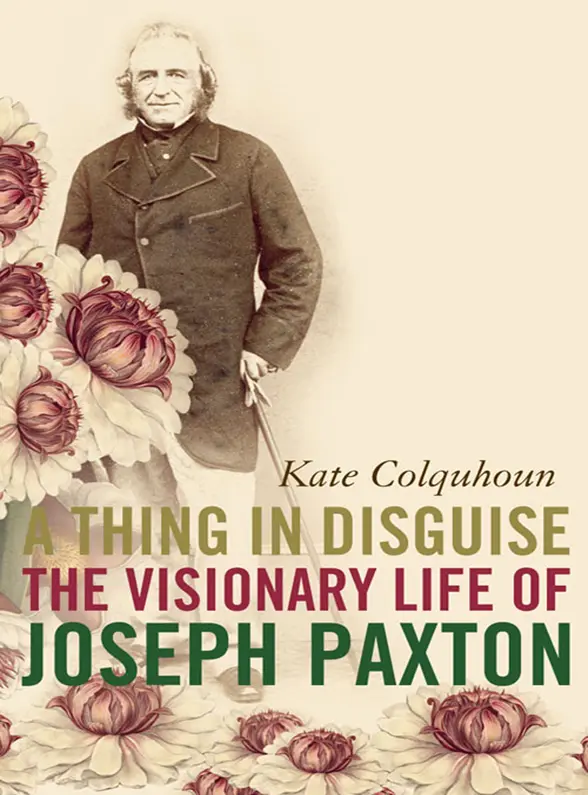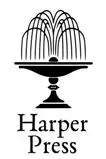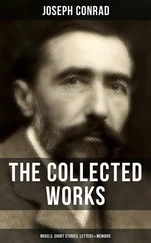
KATE COLQUHOUN
A THING IN DISGUISE
THE VISIONARY LIFE OF
JOSEPH PAXTON

For David
She did not have to be told … that glass is a thing in disguise, an actor, is not solid at all, but liquid, that an old sheet of glass will not only take on a royal and purplish tinge but will reveal its true liquid nature by having grown fatter at the bottom and thinner at the top, and that even while it is as frail as the ice on a Paramatta puddle, it is stronger under compression than Sydney sandstone, that it is invisible, solid, in short, a joyous and paradoxical thing, as good a material as any to build a life from.
Peter Carey, Oscar and Lucinda
Cover
Title Page
Dedication
Epigraph
Prologue
Part 1 : Earth
Chapter One
Chapter Two
Chapter Three
Chapter Four
Chapter Five
Chapter Six
Chapter Seven
Chapter Eight
Chapter Nine
Chapter Ten
Chapter Eleven
Chapter Twelve
Chapter Thirteen
Chapter Fourteen
Part 2 : Air
Chapter Fifteen
Chapter Sixteen
Chapter Seventeen
Chapter Eighteen
Chapter Nineteen
Chapter Twenty
Part 3 : Fire
Chapter Twenty-One
Chapter Twenty-Two
Chapter Twenty-Three
Chapter Twenty-Four
Chapter Twenty-Five
Notes
A Note on Currency
Select Bibliography
Index
Appendix
Acknowledgements
About the Author
Praise for A Thing in Disguise
Copyright
About the Publisher
Just after 7 p.m. on Monday, 30 November 1936, a small fire started under the central transept of the Crystal Palace in south London, the greatest glasshouse ever built.
Preparations for The National Cat Show to begin the next day had just been finalised. A choir was rehearsing in the garden room, birds ruffled their feathers in the aviaries. Otherwise the Palace – with its nave of 1,608 feet and main transept larger than the dome of St Peter’s in Rome – was still. Its enormous frosty surface, made up of over 1,500,000 square feet of glass, glittered and, as the moon emerged occasionally from the cloud, it struck the statues in the formal, terraced gardens spreading out below the building. In the surrounding boroughs, families prepared their evening meals and planned their Christmases.
The two Palace nightwatchmen on duty that evening were rather slow on the uptake. Their first call was made to the Penge Fire Brigade just before eight o’clock, by which time the flames could be seen clearly from outside the building and street fire alarms were being activated all over the area. At 7.45 p.m. Police Constable Parkin, passing on a bus, was one of many who also called the brigade. They arrived at 8.03 p.m. with their one, slow fire engine. Beckenham Fire Brigade followed within a couple of minutes, and soon a call went out to all the brigades in London to join them. On the great ridge, a fresh force 5 wind from the north-west fanned the fire like bellows and drove it down the giant south nave. Within 30 minutes, all the central parts of the building were ablaze – wild waves of flame battered relentlessly against the glass and leapt right up to the roof. Encouraged by the wind, the fire devoured the great stage and organ, the 20,000 chairs stored underneath and the floors themselves. It fed on the figures in a waxwork exhibition, the plants and trees, the stuffed animals and the various exhibits. It reached such an astonishing intensity of heat that the iron framework glowed white, buckled and, one by one, the vast glass panes began to explode.
As armies of fire fighters and fire engines with their bells clanging arrived from all over London, the practising choir was evacuated, the exotic birds in the aviaries freed from their cages to fly up into the smoke and take their chances. The gas company worked fast to dig a trench to cut off the main gas supply Air forced through the organ pipes caused it to groan accompaniment. Motor pumps and turntable ladders were set up on the wide parade. Precariously balanced firemen turned scores of hoses on the fire and the new hose-lorry of the London Fire Brigade, which could reel out 1½ miles of hose at a speed of 15 miles an hour, was used for the first time after being demonstrated only the afternoon before. However, the brigade could do little but delay the inevitable. High on the hill the water pressure was simply not strong enough. Using the five million gallons of water available in the upper reservoir, still the hoses had negligible effect. Just short of an hour after the fire began, the entire building was in flames and the firemen had to retreat to 100 feet beyond the glowing mass.
Clouds of smoke stretched for miles. An exaggerated, orange glow took over the sky. It was seen in eight counties – as far as Devil’s Dyke near Brighton, about 50 miles away – causing hundreds of thousands of people to converge on the high ground of the South Downs at Epsom and on Hampstead Heath across the Thames. Tens of thousands more swarmed by every means to the Palace itself, hampering the emergency services in their race to the hill. One newspaper later reported that a parked car, used as a grandstand by hordes of onlookers, collapsed and was found the following day with its tyres burst and its wheels splayed at each corner. Many hundreds of bicycles were deserted as it became impossible to ride or push them through the dense crowds.
Throughout the 82 years it stood on Penge Hill, the Palace and its gardens had become London’s most famous resort, renowned above all for its music and for the great organ with its 3,714 speaking pipes. Over one million people visited each year to attend the Saturday festivals, wander through the historical courts or gaze at Benjamin Waterhouse Hawkins’ giant dinosaur replicas. Here they enjoyed the firework displays, tightrope walkers and wild animals and cheered at cricket matches and dirt-track motorbike races. It had become a national monument for old and young well before it became national property in 1913.
Even the Duke of Kent joined the crowds to watch the fire. From every window, every tree and every available railing, people were mesmerised by the destruction of their poor old palace. One enterprising man in Hillside Road, Streatham, hired out field glasses for twopence a look. In Parliament, MPs and Lords packed the upstairs committee rooms and terraces for a view of the angry sky.
The ferocity of the fire was awe-inspiring. By 8.35, the ribs of the vast central transept roof had become a stark black skeleton against the white blaze, visibly bent and twisted. With a roar and an explosion of sparks that carried for miles, they collapsed. Just before nine o’clock, the modular arched girders of the south transept began to fall like hoops, one by one in a macabre reversal of their construction. The halls, the great organ, the immense library of Handel Festival music were gone. The vast stone steps to the terraces were shattered by the falling face of the transept, molten glass dropped from the great girders. The firemen were dwarfed against the great bowl of flame, as streams of molten glass poured down outside the building, forcing them back. Explosions rocked the neighbourhood as the fire reached the boilers in the basement, frightening a carpet of rats that streamed out across the park. The water in the central fountain inside the building boiled and the fish perished.
Читать дальше













